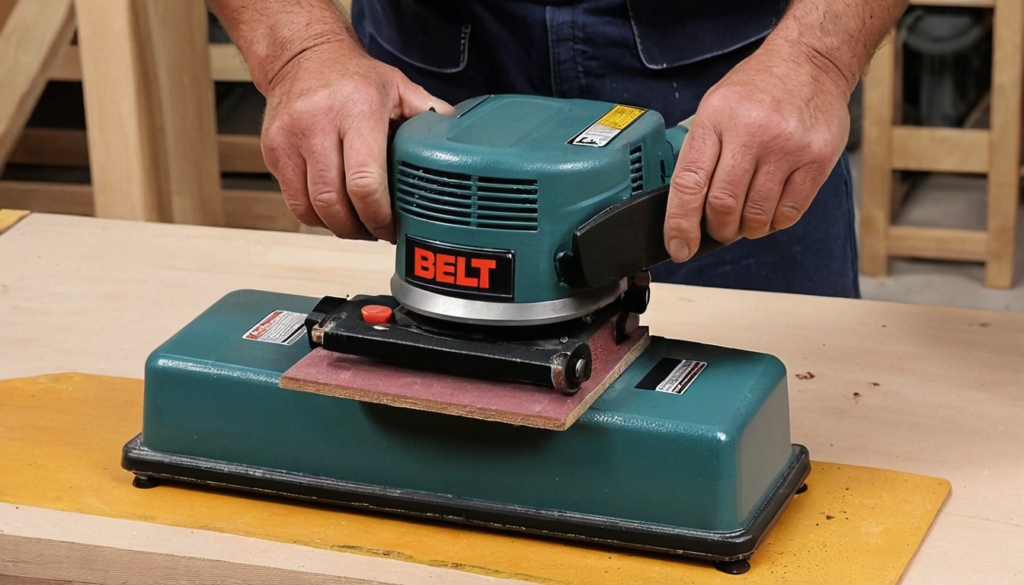A belt sander is a versatile power tool that can significantly enhance your woodworking projects. By understanding its mechanics, key features, and proper usage, you can achieve professional-quality results in less time. This comprehensive guide will delve into the world of belt sanders, providing you with the knowledge and skills to optimize your woodworking endeavors.

How a Belt Sander Works
A belt sander consists of an endless loop of abrasive paper, or belt, that runs over two pulleys. The motor powers the pulleys, causing the belt to move at high speed, effectively sanding away material. The adjustable work table allows you to position your workpiece at various angles, providing flexibility for different sanding tasks.
Key Benefits of a Belt Sander
- Efficiency: Belt sanders excel at rapidly removing large amounts of material. This makes them ideal for shaping rough edges, leveling uneven surfaces, and preparing wood for subsequent finishing steps.
- Versatility: By adjusting the angle of the work table and using different grit sizes of sandpaper, you can tackle a wide range of tasks, from coarse shaping to fine finishing.
- Control: While belt sanders are powerful tools, they offer a surprising degree of control. With practice, you can achieve precise results and avoid accidental damage to your workpiece.
Essential Features to Consider
When purchasing a belt sander, consider the following features:
- Belt Size: Larger belt sizes offer greater sanding capacity and can handle larger workpieces.
- Variable Speed: A variable-speed control allows you to adjust the belt speed to suit different materials and applications.
- Dust Collection: An effective dust collection system helps maintain a clean workspace and improves air quality.
- Ergonomic Design: A comfortable grip and well-balanced design can reduce fatigue during extended use.
Tips for Effective Belt Sander Usage
- Start with a Coarse Grit: Begin with a coarse-grit sandpaper to remove significant amounts of material. As you progress, switch to finer grits for smoother finishes.
- Maintain Consistent Pressure: Apply even pressure to the workpiece to ensure consistent sanding. Avoid pressing too hard, as this can lead to burn marks or uneven results.
- Keep the Belt Clean: Regularly clean the belt to remove debris and maintain its effectiveness. A clogged belt can reduce sanding efficiency and produce poor results.
- Use a Dust Mask and Eye Protection: Belt sanders generate a significant amount of dust, so it’s essential to wear appropriate safety gear to protect your lungs and eyes.
- Work with the Grain: Sanding with the grain of the wood produces a smoother finish and minimizes the risk of scratches.
- Take Frequent Breaks: Prolonged use of a belt sander can lead to fatigue and discomfort. Take regular breaks to rest your hands and arms.
- Inspect the Belt Regularly: Check the belt for wear and tear. A worn-out belt can produce uneven results and increase the risk of accidents.
Common Belt Sander Projects
Belt sanders are invaluable tools for a variety of woodworking projects, including:
- Shaping Edges: Create smooth, rounded edges on boards and other components.
- Leveling Surfaces: Remove high spots and level uneven surfaces on wooden boards.
- Removing Old Finish: Strip away old paint or varnish before refinishing.
- Preparing for Staining or Painting: Smooth the surface of the wood to ensure a uniform finish.
- Creating Custom Shapes: Shape intricate curves and contours in your woodworking projects.
By understanding the principles of belt sander operation and following these tips, you can harness the power of this versatile tool to achieve exceptional results in your woodworking endeavors. Remember to prioritize safety, practice regularly, and experiment with different techniques to master the art of belt sanding.
Also Read This Article Boho Braids



